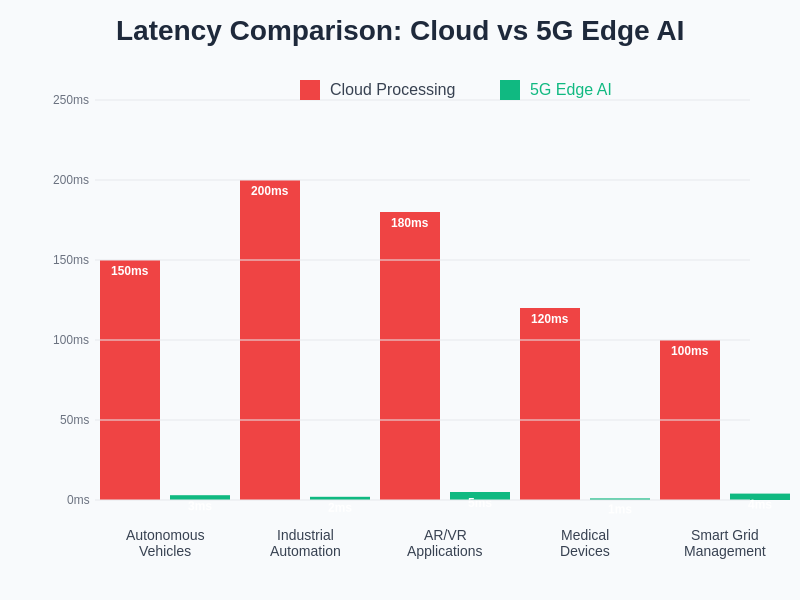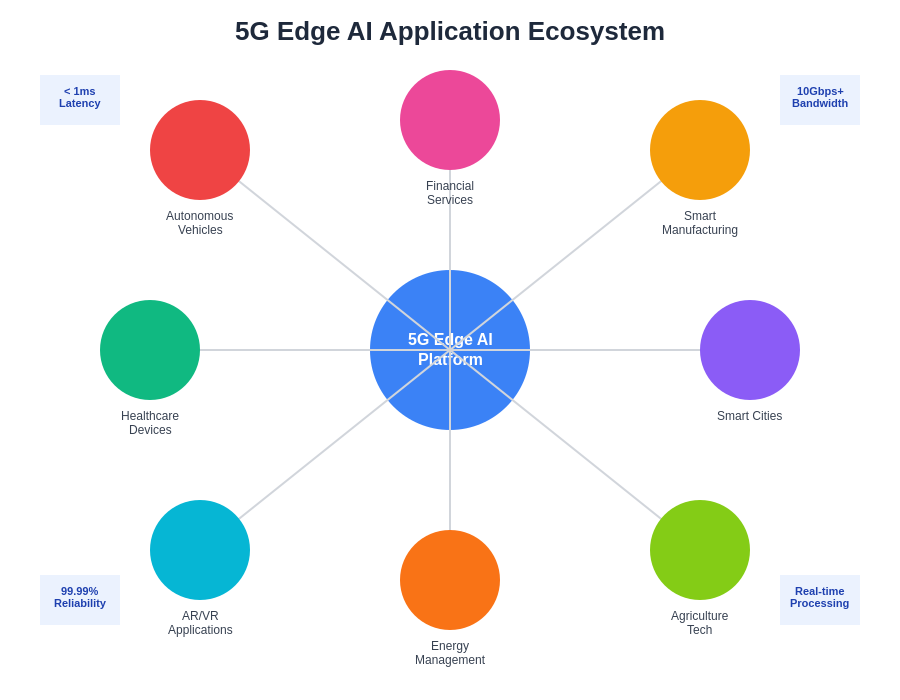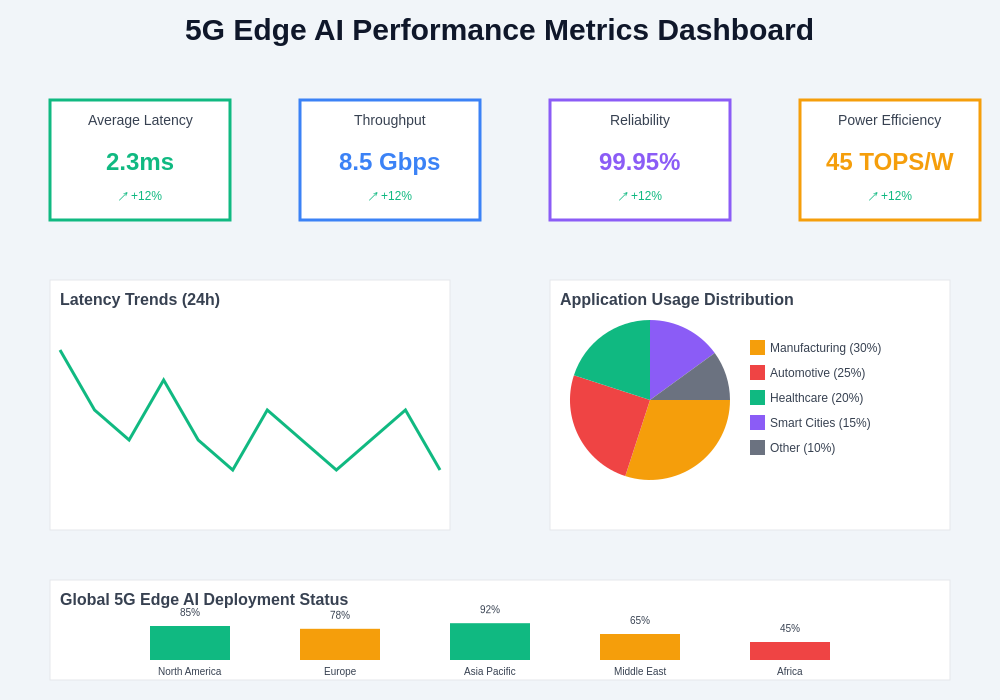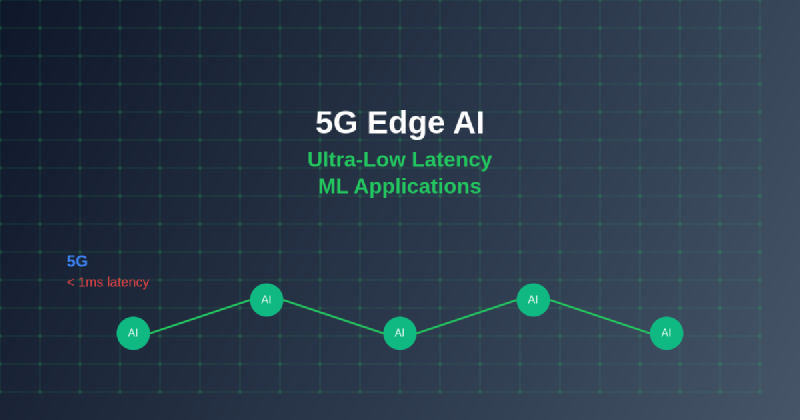The convergence of 5G wireless technology and edge artificial intelligence represents one of the most transformative developments in modern computing infrastructure, fundamentally reshaping how machine learning applications process data and deliver insights. This revolutionary combination enables unprecedented ultra-low latency performance that was previously impossible with traditional cloud-based architectures, opening new frontiers for real-time AI applications that demand instantaneous responses and mission-critical reliability.
Stay updated with the latest 5G and AI developments as these technologies continue to evolve and create new possibilities for intelligent edge computing solutions. The synergy between 5G’s enhanced connectivity capabilities and edge AI’s distributed processing power is creating a new paradigm where intelligent decision-making happens at the network edge, dramatically reducing the time between data collection and actionable insights.
The Foundation of 5G Edge AI Architecture
The architectural foundation of 5G edge AI systems represents a fundamental departure from traditional centralized cloud computing models, distributing computational intelligence across a network of edge nodes that operate in close proximity to data sources and end users. This distributed approach leverages 5G’s ultra-reliable low-latency communication capabilities to create a seamless mesh of interconnected processing nodes that can collaboratively execute complex machine learning workloads while maintaining millisecond-level response times.
The sophisticated network slicing capabilities inherent in 5G technology enable the creation of dedicated virtual networks optimized specifically for AI workloads, ensuring that machine learning applications receive guaranteed bandwidth, latency, and reliability characteristics tailored to their specific requirements. This level of network customization allows different AI applications to coexist on the same physical infrastructure while maintaining isolation and performance guarantees that are essential for mission-critical deployments.
The integration of edge computing resources directly into 5G base stations and network infrastructure creates a distributed intelligence layer that can process data locally without requiring round-trip communication to distant cloud data centers. This architectural approach dramatically reduces latency while simultaneously improving data privacy and security by keeping sensitive information within localized processing boundaries.
Revolutionary Latency Performance Metrics
The latency improvements achieved through 5G edge AI deployments represent orders of magnitude enhancement over traditional cloud-based machine learning architectures, with end-to-end processing times frequently measuring in single-digit milliseconds rather than the hundreds of milliseconds typical of cloud-centric approaches. These dramatic performance improvements enable entirely new categories of real-time AI applications that were previously technically infeasible due to latency constraints.

The ultra-low latency characteristics of 5G edge AI systems stem from the elimination of multiple network hops and the strategic placement of processing resources at the network edge, where data can be analyzed and acted upon immediately upon collection. This architectural optimization reduces the total system latency to levels that approach the theoretical limits imposed by the speed of light, enabling applications that require near-instantaneous responses to environmental changes or user inputs.
Experience next-generation AI capabilities with Claude to understand how advanced reasoning and processing can be optimized for edge deployment scenarios. The combination of sophisticated AI models with ultra-low latency infrastructure creates opportunities for applications that can respond to complex situations with human-like intelligence but at superhuman speeds.
Autonomous Vehicle Intelligence and Safety Systems
The automotive industry represents one of the most compelling applications of 5G edge AI technology, where ultra-low latency machine learning enables autonomous vehicles to make split-second decisions based on real-time analysis of sensor data, traffic conditions, and environmental factors. These systems must process vast amounts of visual, radar, and lidar data while coordinating with other vehicles and infrastructure elements to ensure safe navigation through complex traffic scenarios.
The integration of 5G connectivity with edge AI processing enables vehicles to share critical safety information instantaneously with other vehicles and traffic management systems, creating a collaborative intelligence network that can predict and prevent accidents before they occur. This vehicle-to-everything communication capability, combined with local AI processing power, allows autonomous vehicles to respond to hazardous conditions in timeframes measured in milliseconds rather than the hundreds of milliseconds required for cloud-based processing.
Advanced driver assistance systems benefit enormously from edge AI capabilities that can analyze road conditions, identify potential hazards, and coordinate emergency responses without relying on potentially unreliable internet connections to distant data centers. The ability to process critical safety decisions locally while maintaining connectivity for non-critical functions represents a perfect balance between performance and reliability for automotive applications.
Industrial Automation and Smart Manufacturing
Manufacturing environments have embraced 5G edge AI as a transformative technology for implementing intelligent automation systems that can adapt to changing conditions in real-time while maintaining the precise timing requirements essential for industrial processes. These systems leverage machine learning algorithms running on edge computing platforms to optimize production workflows, predict equipment failures, and maintain quality control standards with unprecedented precision and responsiveness.
The ultra-low latency characteristics of 5G edge AI enable manufacturing robots and automated systems to coordinate complex assembly operations with millisecond-level precision, allowing for more sophisticated and flexible production processes that can adapt to variations in materials, environmental conditions, or product specifications without human intervention. This level of real-time adaptability was previously impossible with cloud-based AI systems due to network latency and reliability constraints.
Predictive maintenance applications powered by edge AI can continuously monitor equipment health through sensor data analysis and immediately identify potential failure modes before they result in costly downtime or safety hazards. The ability to process vibration, temperature, and performance data locally enables manufacturing systems to implement corrective actions automatically, optimizing maintenance schedules and extending equipment lifespan while minimizing operational disruptions.
Healthcare and Medical Device Innovation
The healthcare sector has witnessed revolutionary applications of 5G edge AI in medical devices and patient monitoring systems that require real-time analysis of physiological data to provide immediate interventions or alerts. These applications demand not only ultra-low latency but also the highest levels of reliability and security, making edge processing an ideal solution for critical medical applications where patient safety depends on immediate response to changing conditions.
Remote surgery applications represent one of the most demanding use cases for 5G edge AI, where surgical robots must respond to surgeon commands and patient conditions with latency measured in single milliseconds to ensure precise and safe operations. The combination of 5G’s ultra-reliable low-latency communication with edge AI processing enables surgeons to perform complex procedures remotely while maintaining the tactile feedback and real-time control necessary for successful outcomes.
Continuous patient monitoring systems benefit from edge AI capabilities that can analyze vital signs, detect anomalies, and alert medical staff to critical changes without relying on cloud connectivity that might be interrupted or delayed. These systems can implement machine learning algorithms that learn individual patient patterns and provide personalized health insights while maintaining patient privacy through local data processing.
Augmented and Virtual Reality Experiences
The entertainment and training industries have leveraged 5G edge AI to create immersive augmented and virtual reality experiences that require real-time rendering and interaction capabilities previously impossible with traditional computing architectures. These applications demand not only ultra-low latency but also massive computational power to generate realistic graphics and respond to user interactions in real-time.
Virtual reality training simulations for high-risk occupations such as aviation, medicine, and emergency response benefit enormously from edge AI processing that can adapt scenarios dynamically based on trainee performance while maintaining the visual fidelity and responsiveness necessary for effective learning outcomes. The ability to process complex simulations locally while coordinating with cloud-based content libraries creates training experiences that are both highly realistic and infinitely customizable.
Augmented reality applications in retail, education, and industrial maintenance leverage edge AI to overlay contextual information onto real-world environments with precise tracking and minimal delay, creating seamless integration between digital and physical worlds. These applications require sophisticated computer vision algorithms running on edge hardware to identify objects, track movements, and render appropriate digital content in real-time.
Enhance your research capabilities with Perplexity to explore the latest developments in immersive technology and edge computing applications. The rapid advancement of both hardware and software technologies continues to expand the possibilities for creating compelling and useful augmented reality experiences.
Smart City Infrastructure and Public Safety
Urban environments are increasingly implementing 5G edge AI systems to create intelligent infrastructure that can respond dynamically to changing conditions while optimizing resource utilization and enhancing public safety. These systems integrate data from thousands of sensors, cameras, and IoT devices to provide real-time insights into traffic patterns, environmental conditions, and security threats.
Traffic management systems powered by edge AI can analyze vehicle flow patterns, predict congestion, and optimize signal timing in real-time to reduce travel times and emissions while improving overall transportation efficiency. The ability to process traffic data locally at intersection-level edge nodes enables coordination between multiple traffic signals and dynamic route optimization that responds immediately to changing conditions.
Public safety applications leverage edge AI for real-time video analysis that can identify potential security threats, detect unusual behavior patterns, and coordinate emergency response activities without requiring transmission of sensitive video data to remote processing centers. These systems maintain privacy while providing enhanced security through local processing of surveillance data and immediate alerting capabilities.
Energy Management and Smart Grid Applications
The energy sector has embraced 5G edge AI for implementing intelligent grid management systems that can balance supply and demand in real-time while integrating renewable energy sources and optimizing distribution efficiency. These applications require millisecond-level response times to maintain grid stability and prevent cascading failures that could result in widespread power outages.
Smart grid applications powered by edge AI can predict energy demand patterns, optimize renewable energy integration, and automatically reconfigure distribution networks to maintain optimal efficiency and reliability. The ability to process energy data locally at substations and distribution points enables immediate response to changing conditions without relying on potentially vulnerable communication links to centralized control centers.
Energy storage systems benefit from edge AI processing that can optimize charging and discharging cycles based on real-time analysis of grid conditions, energy prices, and demand forecasts, maximizing the economic and operational benefits of distributed energy storage while maintaining grid stability and reliability.

The diverse ecosystem of 5G edge AI applications spans multiple industries and use cases, each leveraging the unique combination of ultra-low latency processing and high-bandwidth connectivity to enable previously impossible real-time intelligent applications.
Agricultural Technology and Precision Farming
Modern agriculture has adopted 5G edge AI technologies to implement precision farming systems that can monitor crop health, optimize irrigation and fertilization, and predict harvest timing with unprecedented accuracy and responsiveness. These applications leverage real-time analysis of sensor data, satellite imagery, and environmental conditions to make immediate adjustments to farming practices that maximize yield while minimizing resource consumption.
Autonomous farming equipment powered by edge AI can navigate fields, identify crop conditions, and apply treatments with precision that surpasses human capabilities while operating continuously without fatigue or error. The ability to process visual and sensor data locally enables these systems to adapt to changing field conditions immediately, optimizing farming operations for maximum efficiency and sustainability.
Livestock monitoring systems benefit from edge AI processing that can track animal health, behavior, and location in real-time, enabling early detection of health issues and optimization of feeding and care schedules. These systems provide farmers with immediate insights into animal welfare while reducing the labor requirements for monitoring large herds or flocks.
Financial Services and High-Frequency Trading
The financial services industry has implemented 5G edge AI systems for high-frequency trading applications that require microsecond-level latency to capitalize on market opportunities and manage risk effectively. These applications demand not only ultra-low latency but also extremely high reliability and security to protect sensitive financial data and ensure consistent performance during high-volume trading periods.
Fraud detection systems powered by edge AI can analyze transaction patterns in real-time to identify suspicious activities and prevent fraudulent transactions before they complete, protecting both financial institutions and their customers from financial losses. The ability to process transaction data locally reduces latency while maintaining security through encrypted local processing that minimizes exposure of sensitive financial information.
Risk management applications leverage edge AI to continuously monitor market conditions, portfolio performance, and external factors that might impact investment strategies, enabling immediate adjustments to trading algorithms and risk parameters based on real-time market analysis and predictive modeling.
Retail and Customer Experience Enhancement
Retail environments have transformed customer experiences through 5G edge AI implementations that enable personalized shopping experiences, intelligent inventory management, and enhanced security systems that operate seamlessly in real-time. These applications leverage customer behavior analysis, inventory tracking, and environmental monitoring to create shopping experiences that are both highly personalized and operationally efficient.
Intelligent checkout systems powered by edge AI can identify products, process payments, and manage inventory automatically without requiring traditional scanning or cashier interaction, creating frictionless shopping experiences that reduce wait times while maintaining accuracy and security. The ability to process visual recognition and payment data locally ensures customer privacy while enabling sophisticated analytics for business optimization.
Inventory management systems benefit from edge AI processing that can track product movement, predict demand patterns, and optimize restocking schedules based on real-time analysis of sales data, customer behavior, and supply chain conditions. These systems enable retailers to maintain optimal inventory levels while minimizing waste and maximizing customer satisfaction.
Security and Privacy Considerations
The implementation of 5G edge AI systems introduces unique security and privacy considerations that must be carefully addressed to ensure the protection of sensitive data and the integrity of critical applications. Edge processing offers inherent privacy advantages by keeping data local, but it also creates new attack vectors and security challenges that require sophisticated protective measures.
Data protection in edge AI systems requires implementing robust encryption, access controls, and secure communication protocols that protect information throughout the entire processing pipeline while maintaining the performance characteristics essential for ultra-low latency applications. The distributed nature of edge computing creates additional complexity in security management but also provides opportunities for implementing defense-in-depth strategies that are more resilient than centralized approaches.
Network security for 5G edge AI deployments must address both the wireless communication links and the edge computing infrastructure, implementing comprehensive monitoring and threat detection systems that can identify and respond to security incidents in real-time without impacting application performance or availability.
Future Development Trajectories
The evolution of 5G edge AI technology continues to accelerate, with ongoing developments in hardware optimization, algorithm efficiency, and network infrastructure that promise even greater performance improvements and new application possibilities. These advancements are driven by the increasing demand for real-time AI capabilities across diverse industries and the continued miniaturization and optimization of edge computing hardware.
Emerging applications in fields such as space exploration, underwater research, and extreme environment monitoring are pushing the boundaries of what is possible with edge AI systems, requiring innovations in hardware design, algorithm optimization, and system reliability that will benefit all edge AI applications. The lessons learned from these demanding applications continue to drive improvements in commercial edge AI deployments.
The integration of quantum computing elements into edge AI systems represents a potential revolutionary advancement that could enable entirely new categories of real-time AI applications with computational capabilities far beyond current systems. While still in early development stages, quantum-enhanced edge AI could transform fields requiring complex optimization and simulation calculations that are currently computationally prohibitive.

The comprehensive performance characteristics of 5G edge AI systems demonstrate the revolutionary improvements in latency, throughput, and reliability that enable new categories of real-time intelligent applications across diverse industries and use cases.
Implementation Strategies and Best Practices
Successful deployment of 5G edge AI systems requires careful consideration of hardware selection, software optimization, and network configuration to achieve optimal performance while maintaining cost-effectiveness and operational reliability. These implementation strategies must balance performance requirements with practical constraints such as power consumption, physical space limitations, and maintenance accessibility.
Hardware optimization for edge AI deployments involves selecting processing units, memory configurations, and storage systems that provide the necessary computational power while operating within the power and thermal constraints typical of edge environments. The choice of specialized AI accelerators, general-purpose processors, and memory architectures significantly impacts both performance and operational costs.
Software optimization strategies focus on algorithm efficiency, model compression, and resource management techniques that maximize the utilization of available hardware resources while maintaining the accuracy and reliability required for specific applications. These optimizations often involve trade-offs between model complexity and processing speed that must be carefully balanced based on application requirements.
Economic Impact and Industry Transformation
The widespread adoption of 5G edge AI technology is driving significant economic transformation across multiple industries, creating new business models, improving operational efficiency, and enabling entirely new categories of products and services that were previously technically infeasible. This economic impact extends beyond direct technology benefits to include broader societal improvements in healthcare, transportation, energy efficiency, and environmental sustainability.
Cost reduction opportunities through edge AI implementation include decreased cloud computing expenses, reduced bandwidth requirements, improved operational efficiency, and enhanced productivity through automation and intelligent decision-making systems. These economic benefits often justify the initial investment in edge infrastructure through relatively short payback periods and ongoing operational savings.
New revenue opportunities created by edge AI capabilities include innovative service offerings, improved customer experiences, enhanced product differentiation, and the ability to enter previously inaccessible markets that require real-time AI capabilities. These opportunities are driving significant investment in edge AI technology development and deployment across diverse industries.
Challenges and Limitations
Despite the significant advantages of 5G edge AI systems, several challenges and limitations must be addressed to ensure successful implementation and operation. These challenges include technical complexity, infrastructure requirements, standardization issues, and the need for specialized expertise in both AI and edge computing technologies.
Technical challenges in edge AI deployment include managing distributed systems complexity, ensuring consistent performance across diverse hardware platforms, maintaining synchronization between edge nodes, and implementing effective load balancing and fault tolerance mechanisms. These challenges require sophisticated management systems and careful architectural planning to address effectively.
Infrastructure requirements for 5G edge AI systems include significant investments in edge computing hardware, network infrastructure upgrades, and ongoing maintenance and support capabilities. The distributed nature of edge systems can increase operational complexity and require new approaches to system monitoring, troubleshooting, and updates.
The continued evolution of 5G edge AI technology represents one of the most significant technological developments of the modern era, with implications that extend far beyond traditional computing applications to reshape entire industries and create new possibilities for intelligent, responsive systems that can adapt to changing conditions in real-time. As these technologies continue to mature and become more accessible, their transformative impact on society, business, and daily life will only continue to grow, creating a future where intelligent edge computing enables previously unimaginable applications and experiences.
Disclaimer
This article is for informational purposes only and does not constitute professional advice. The views expressed are based on current understanding of 5G and edge AI technologies and their applications across various industries. Readers should conduct their own research and consider their specific requirements when implementing 5G edge AI solutions. The effectiveness and performance of edge AI systems may vary depending on specific use cases, infrastructure requirements, and implementation approaches. Network performance and coverage may vary by location and service provider.
